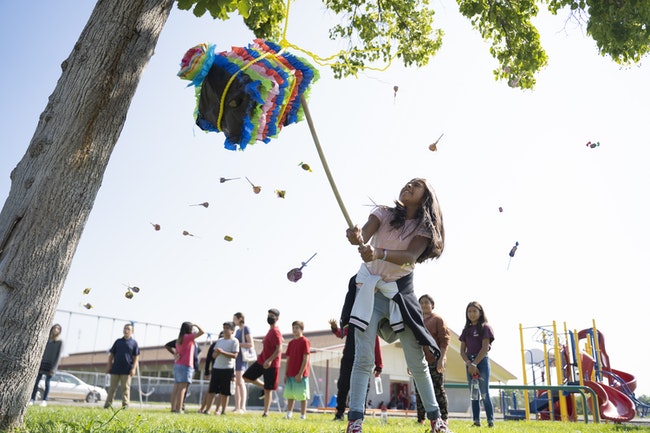
An Ontario student hits a piñata made by Yuliana Martinez and Becky Cuevas’s art class during the last day of summer school. (ANGELINA KATSANIS/The Enterprise)
ONTARIO – “Can you see me?” asked Yuliana Martinez over the speakers. A “YM” icon flickered in gray on the large screen in front of the class.
“Can you see Maestra?” said Becky Cuevas, standing beside the screen.
“No!” chorused the seven students sitting socially distanced around three tables.
Suddenly, the maestra came into focus on the screen. She was wearing white face paint, a traditional Mexican huipil, and gems around her eyes.
The students exclaimed.
“Les gusta?” said Martinez.
The students raised their hands in a thumbs up towards the screen.
Every third, fourth and fifth grade art class at Ontario School District’s summer school this year has had the same special guest: the maestra, or teacher, who video-calls in from Ciudad Miguel Alemán, Tamaulipas. She is part of the Programa Nacional de Educación Migrante, Mexico’s National Migrant Education Program, which is an exchange program for teachers between the U.S. and Mexico.
One of the reasons it exists is to serve Mexican migrant students living in the U.S.
The Ontario district, where Latinx students make up 62% of the student body, has taken part in the program since 2013.
Normally, the program is an in-person exchange, but this year, it has taken place online because of Covid.
“(One objective is) to strengthen knowledge of Mexican history, culture, and values for migrant students located in the United States,” said Martinez.
She said all students attending summer school take part “in order to elevate knowledge of Mexico.”
Through the summer, Martinez and Cuevas taught students Mexican legends, the game of lotería, and about the holiday Día de los Muertos, or the Day of the Dead. During the last week of school, Martinez attended class dressed as a Catrina, a festive skull associated with Día de los Muertos. The students then drew decorated calaveras, or skulls.
Cuevas said that the class’s focus on art was a good way to teach about Mexican culture.
“We just wanted to make sure they were having fun making a connection to another culture, or for some of their culture, but doing it in a way where they don’t realize they’re learning,” she said.
“There are so many questions, sometimes they don’t even want to do our art activities,” said Martinez, explaining that her students were curious about her circumstances.
After a year during which the majority of learning took place online, Cuevas said it was at times difficult for students to grasp that Martinez was off in Mexico instead of somewhere in Ontario like the rest of their teachers.
But the first week of summer school, Martinez sent a video of the bridge in Ciudad Miguel Alemán that crosses the Río Grande River to Roma, Texas. That helped.
Throughout the course of summer school, Martinez took advantage of being at home in Mexico to film other videos as well. Via her camera, students in Ontario got to see a traditional piñata workshop before making their own piñatas in art class.
Both Cuevas and Martinez noted that students generally were highly engaged by the class. Cuevas said that through the activities, the students were expanding their vocabulary and cultural awareness, including of Mexican indigenous cultures, which strongly influence traditions like Día de los Muertos.
“That word isn’t necessarily this language, how do I read it?” said Cuevas, describing her students’ thought process when encountering words with indigenous origins like “xoloscuintle,” a type of hairless dog, and “cempasuchil,” or marigold.
“Everything needs to be broken into a syllable, into a part. Certain things come from certain places,” she said. “I think they’re just a little more aware of the connection and the similarities that the cultures have. I mean, we’re not always so different.”
“We’re able to intertwine the binational piece to art in the special. We’re also able to infuse that (English language development) piece in there,” said Leonel Martinez, summer school principal at May Roberts Elementary School, noting that for some of Yuliana Martinez and Cuevas’s students, Spanish is their dominant language.
The students’ comfort going back and forth between Spanish and English in the art/binational teacher classroom, said Leonel Martinez, “really is just a testament to Becky Cuevas and Yuliana creating a safe environment for all learners to be included, whether they’re bilingual or not.”
On the final day of summer school, there was a carnival during which students had the opportunity to break the piñatas they had made.
When asked what she had learned during art class, Leah, a fifth grader, said “where piñatas come from.”
“We also learned the Day of the Dead,” added Meryan, a fifth grader.
Anthony, a fifth grader, said that his favorite part was “drawing and doing activities and stuff.”
“I’m staying here until we get the candy,” he added, as his classmates took swings at the piñata.
Ontario Mini Market, a Mexican business, set up a tent serving traditional snacks to the students.
“The kids like it,” said Yesica Juarez, who works for the market and said her children had been through Ontario’s summer school program. “Let them continue with the culture, with the tradition, so they don’t forget.”
News tip? Contact reporter Liliana Frankel at [email protected] or 267-981-5577.
EXCELLENCE IN JOURNALISM – Available for $5 a month. Subscribe to the digital service of the Enterprise and get the very best in local journalism. We report with care, attention to accuracy, and an unwavering devotion to fairness. Get the kind of news you’ve been looking for – day in and day out from the Enterprise.




